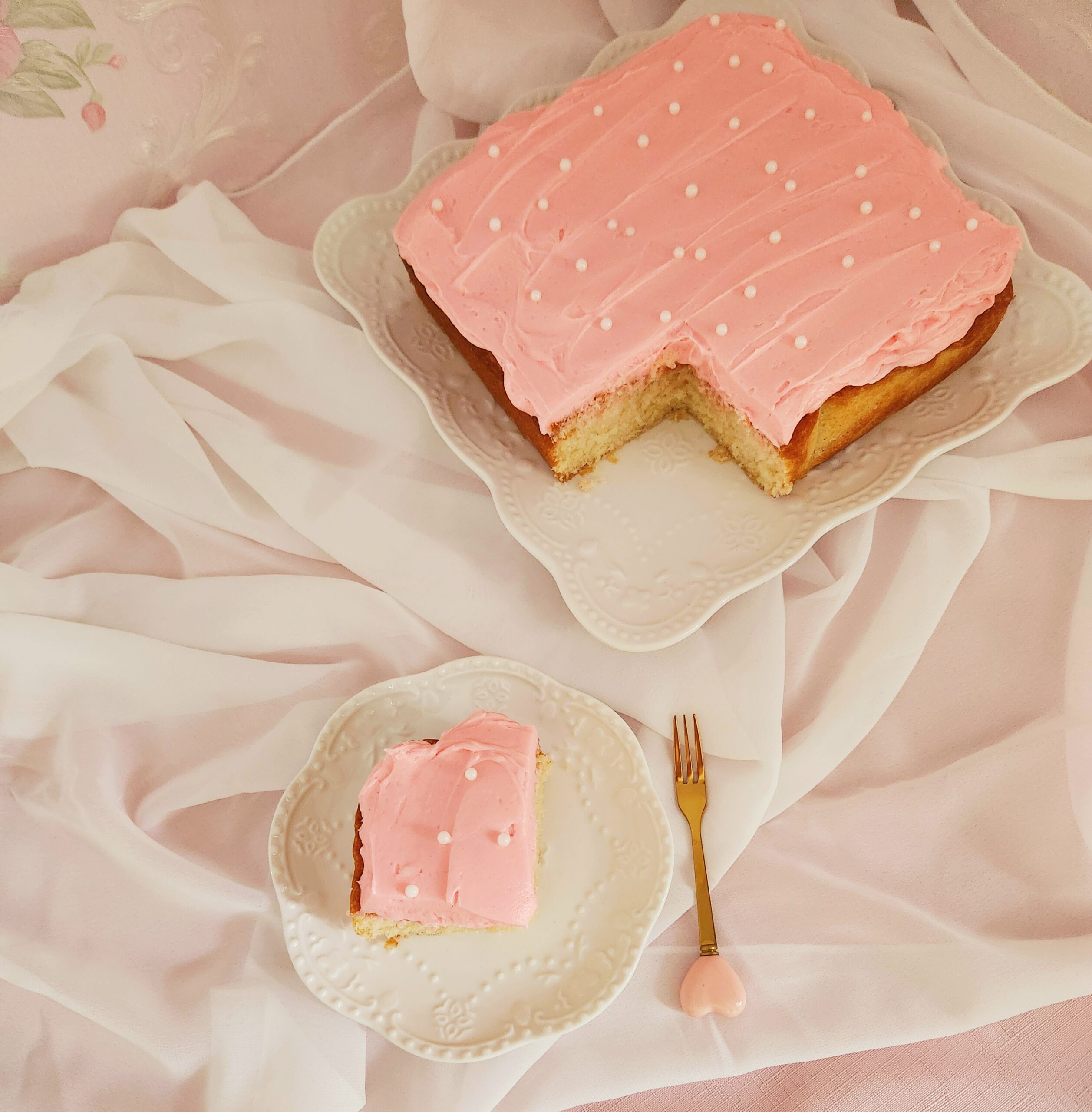
Sometimes, you’re just in the mood for some cake. It isn’t someone’s birthday, no one’s getting married, a graduation isn’t taking place, but why should that stop you? If you want to eat some cake, you absolutely deserve to eat some cake! Your presence is enough of a special occasion to have it. But because this cake is just for you, maybe you don’t want to go through the effort of baking an entire layer cake. Don’t get me wrong, layer cakes have their time and place! They’re great for a party, stretching far enough to make sure everyone gets a satisfactory slice, plus they’re a perfect canvas to decorate beautifully.
They’re also a lot of effort. I know if I’m just baking for myself and my closest loved ones on a random Tuesday, the motivation to make something grand and impressive is incredibly low. I’m just looking to eat some delicious cake, not win a prize. I’m not saying you can’t jazz this cake up if you’re feeling fancy, by all means do! Dye the frosting different colors, pipe some flowers, make a nice boarder, use those expensive sprinkles you’ve been saving for some nondescript special occasion. You’re the cake captain here. I’m just saying, this is a recipe where there’s absolutely no pressure to go all out like that.
This basic white cake is both fast and easy to whip up, a truly beginner friendly treat that doesn’t demand specialty equipment. It makes 9 good sized servings, and will keep in a sealed container for up to 3 days before it starts to go stale. If you’re in a warmer climate or it’s summertime, it needs to be stored in the fridge.
FAQs and Science
I don’t want to have to wait for the butter to soften or the eggs and milk to come up to room temperature, I’m ready to bake and eat my cake now! Is there anything I can do to warm them up quickly? Have no fear, there are tricks you can do to drastically speed up that temperature change.
For the butter, my go-to method uses the microwave. Place the butter on a plate, and zap it for 9-10 seconds. Flip the butter over, so what was the bottom is now the top. Zap it again for another 9-10 seconds. Now turn the butter on its side, and zap it one final time for 9-10 seconds. It’s fast, it’s easy, it softens how you need it to.
The milk is easy, just zap it in the microwave for around 30 seconds, then stir it to make sure the heat has been evenly distributed.
As for the eggs, place them in a bowl and cover them with the hottest water that will come out of your faucet. Leave them like that for a few minutes, and they’ll reach the perfect temperature in no time! I like to do this at the very beginning of my bake, so they’ll warm up as I do things like preheat the oven and sift together the dry ingredients. Efficiency. If the water covering the eggs turns cold before you’re ready to use them, dump it out and cover the eggs once more with hot water.
Why does it matter that my eggs aren’t cold? A cake batter is an emulsified substance. In order for that emulsification to take place, everything needs to be of a similar temperature. That’s why if you add in cold eggs to your creamed butter and sugar, it can easily curdle the mixture and you’re going to have a bad time.
I didn’t listen to you about the egg temperature and now my batter is curdled. Do I need to throw it away and start over? No! There’s an easy way to save your batter and keep pushing forward. You need to heat the outside of the bowl, so the inside mixture will warm up enough to come back together. There are a few ways you can do this:
1. Take a bowl larger than the one your batter is in, fill it partway up with hot water, and dip the bowl with the batter into the water bath for a minute or two, then mix the batter again. Repeat this process until it’s one beautiful, smooth consistency. But what if you’re using the biggest bowl you own to bake in?
2. Grab a kitchen towel, run it under some hot water, and wrap it around the sides of the bowl your batter is in. After a minute or two, start beating your batter again until it’s homogenized. You may need to repeat this step a few times, but trust the process, it will come back together again. But what if you happen to own some more obscure tools and have a flare for danger?
3. Last but not least, my favorite method, using a torch! Now, this only works if the bowl you’re working in is made of metal (melted plastic is, sadly, not very tasty). You need to be extremely careful if you’re going to implore this method, but it works well and fast. Just run the flame of the torch along the outside of the bowl, making sure not to leave it in the same spot for more than a second so as not to completely melt your batter. The goal is to soften it enough to come together, not to turn it into soup. If you can, make sure the batter is mixing as you do this!
Why are you asking me to use to paddle attachment instead of the whisk on my stand mixer? Wouldn’t the whisk be faster? The whisk should only be used for something you’re trying to beat a ton of air into, like a meringue or whipped cream. This particular cake batter doesn’t need that air, it gets its lift from a chemical leavening agent as it bakes, baking powder! The paddle attachment, on the other hand, is designed for bringing this kind of batter together. The shape and amount of contact it gives does a better job of blending everything together so you end up with a beautifully homogeneous batter.
Are there instances where you would use the whisk attachment for a cake? Yes, some cakes depend on the mechanical leavening of incorporating a lot of air, like a genoise, a chiffon, or an angel food cake. But I will always tell you what specific equipment is required for a recipe, so you’ll never have to guess what tools you need to succeed!
Real vanilla extract is expensive, do I have to use it? I’d strongly recommend using some version of real vanilla, whether it’s extract, paste, or scraped in seeds. Vanilla is the primary flavor of the cake, so if you use
imitation, that’s exactly what your cake will taste like.
Can I substitute the cake flour for another kind, like all purpose? You can, but it wont be quite as delicate and tender as it would be with the cake flour. Using an all purpose or a pastry flour will still give you a tasty
product though, so if that’s what you’ve got and you’re not about to go to the store just for a specialty flour that’s not already in your house, feel free to use what’s there! Just make sure you skip the final minute of beating the batter once it’s all come together, as you don’t need that extra bump in gluten development with a higher protein flour.
Why did you include corn syrup in the frosting? I like the slightly gooey texture it adds, almost mimicking the consistency of a canned frosting while still giving you control over what goes into the buttercream.
Can I freeze this cake? Cake actually freezes great! If you want to make the sponge (the baked portion of a cake) ahead of time, make sure it’s all cooled down then tightly wrap it in a few layers of plastic wrap. Take it out the night before you’re ready to serve it and just thaw it on the counter. Hold off on the frosting until it’s thawed and you’re getting ready to serve though, frozen and thawed out frosting needs to be reconstituted (mixed together again) to make sure it’s a nice, smooth texture.
What you’ll need
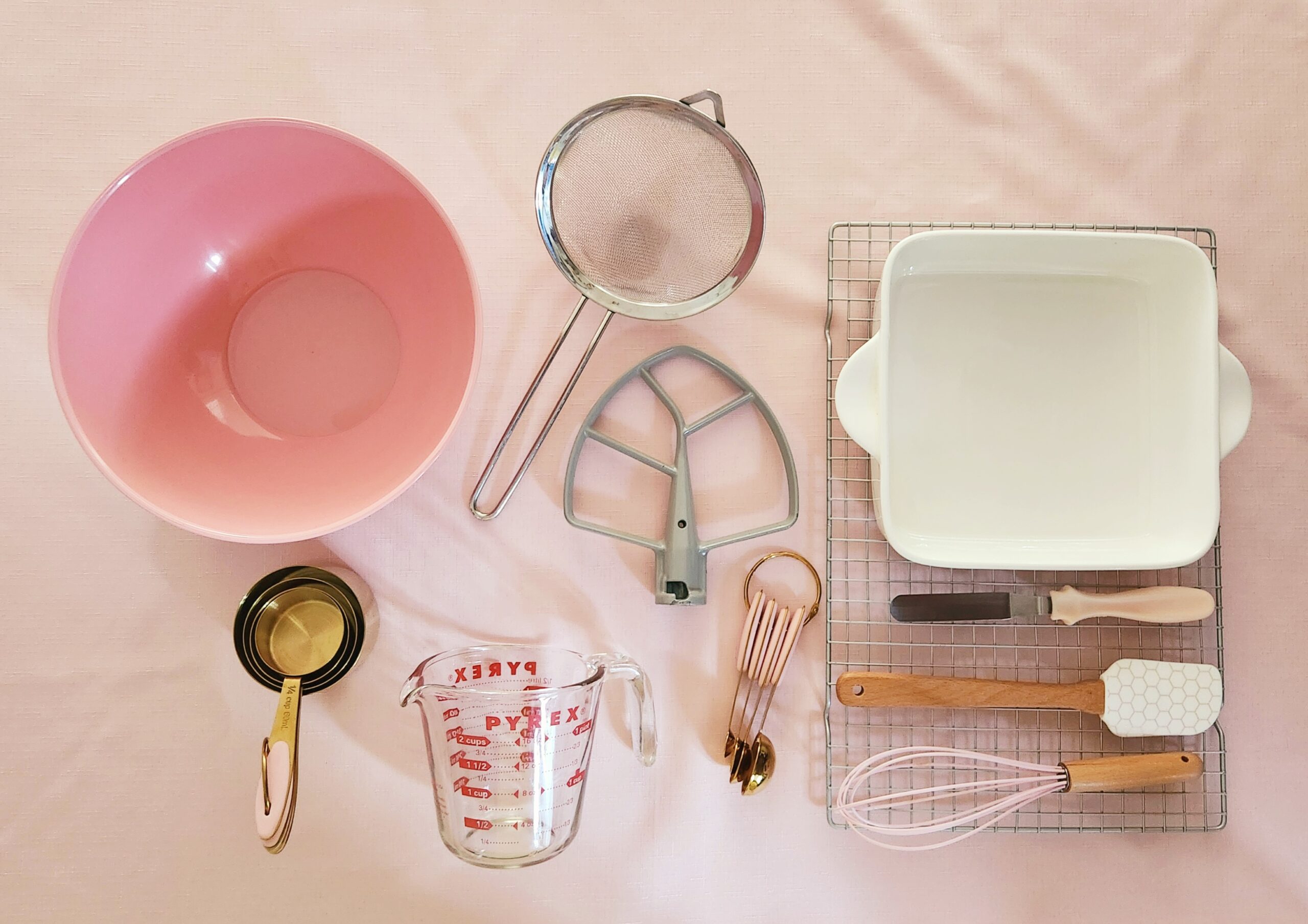
• Large mixing bowl OR the bowl of a stand mixer
• Hand mixer OR stand mixer with the paddle attachment
• Whisk
• Medium mixing bowl
• Rubber spatula
• 8×8 baking pan
• Parchment paper
• Nonstick baking spray
• Sieve
• Measuring cups, dry and liquid
• Measuring spoons
• Cooling rack
• Offset spatula OR butter knife
The Process
Start by preheating your oven to 325, and make sure you’ve gathered all of your needed tools and ingredients. Line the bottom of the baking pan with parchment paper so your cake will easily come out of the pan, and spray the sides of the pan with nonstick baking spray OR smear the sides of the pan with butter. Parchment paper by nature wont stick to anything, so it’s unnecessary to spray that down.
In your medium mixing bowl, sift the cake flour then whisk in the baking powder and salt. This will ensure an even distribution of the dry goods once they’re added to the batter, which will make for a better taste and rise at the end. Set this bowl aside for later.
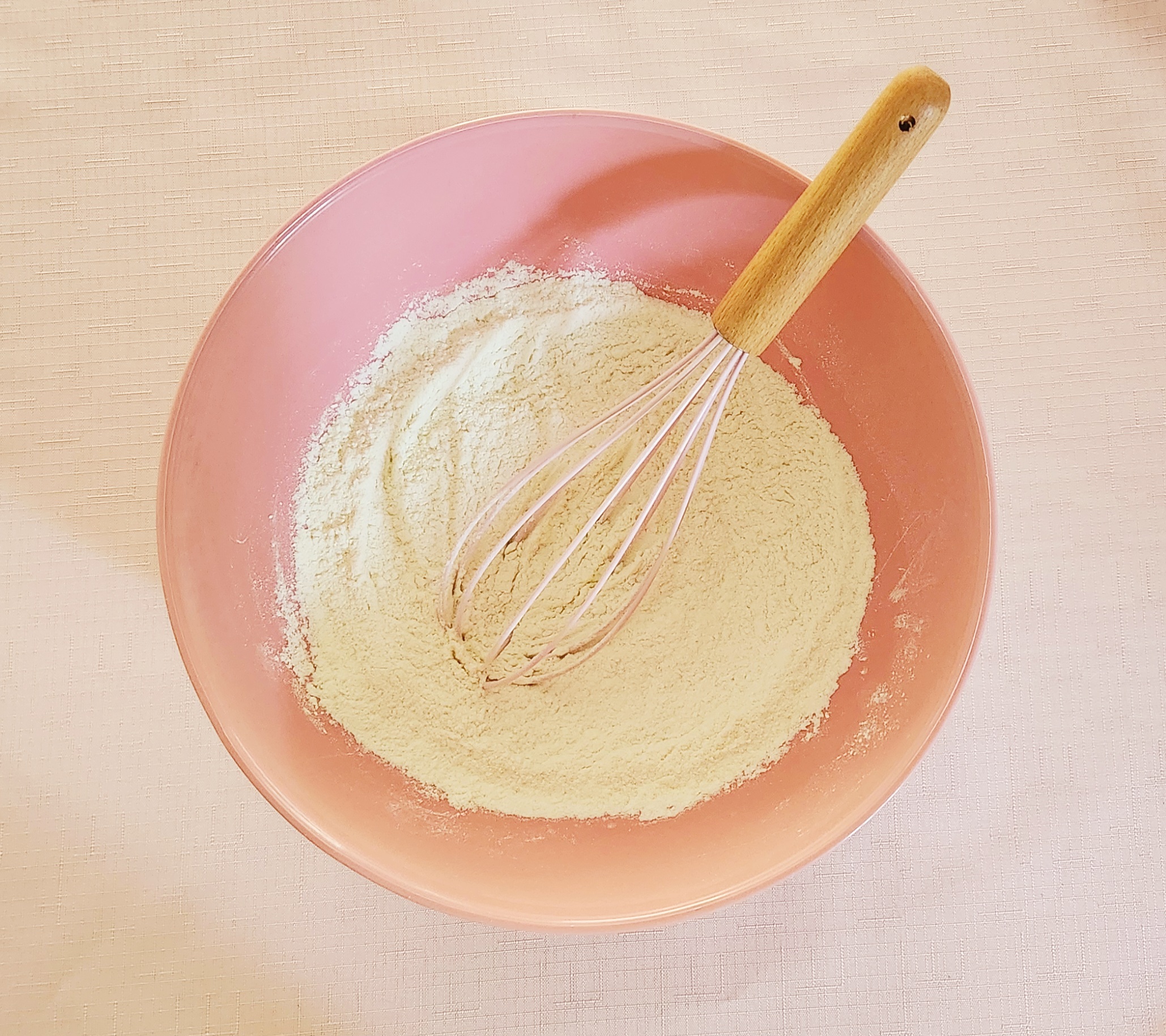
If you’re using a stand mixer with the paddle attachment, add the softened butter and granulated sugar to the bowl of the stand mixer and beat them on level 3 for 2-3 minutes, scraping down the sides of the bowl every so often until they’re creamed together. This should go from a butter yellow color to almost white and fluffy.
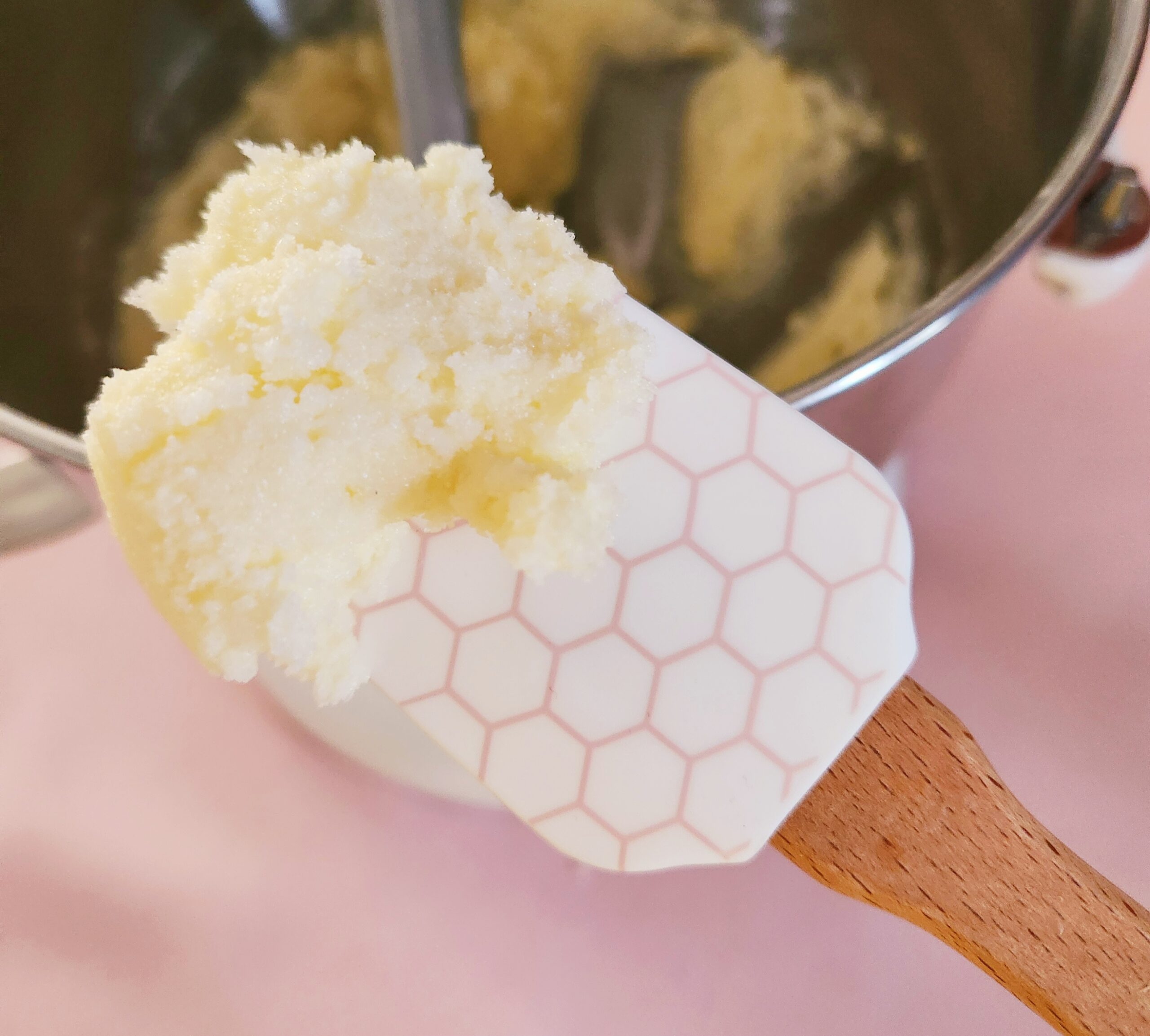
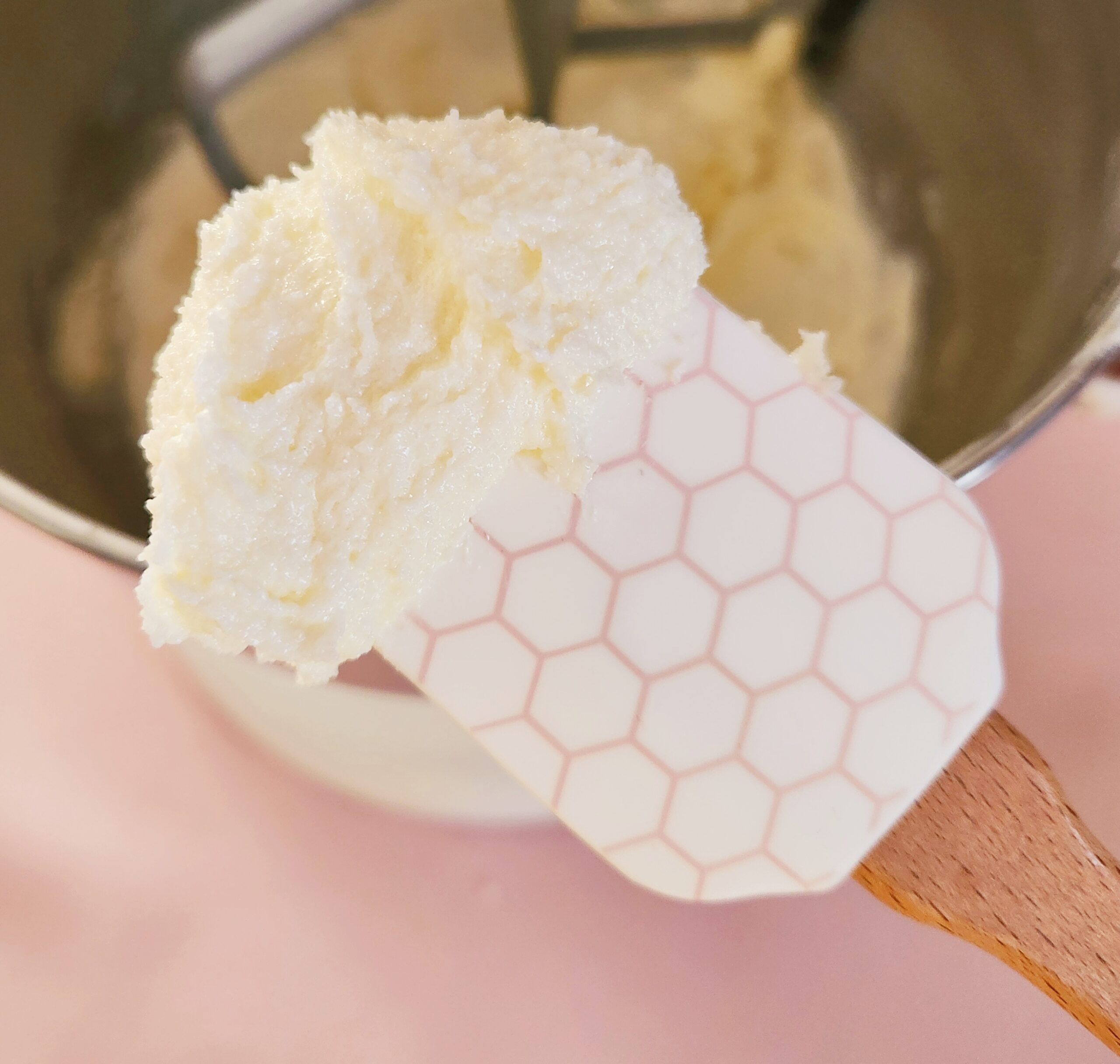
If you’re using a hand mixer, add the softened butter and granulated sugar to the large mixing bowl and beat them on level 2 for 3-4 minutes, or until they’re fully creamed together with that almost white, fluffy consistency. Be sure that the beaters are all the way down in the bowl before turning it on or off, lest you risk butter and sugar flying everywhere.
If you’re using a whisk and your mighty muscles, add the softened butter and granulated sugar to a large mixing bowl and beat them as quickly as you can manage until they’re creamed together with that white, fluffy consistency. How long it will take depends entirely on how quickly you can whisk, so I can’t give you a real time frame. Just look for visual cues that it’s creamed together enough, and take breaks or switch arms when you need to. Baking muscles aren’t ones used very often by most people, so it’s a bit of a workout!
Add in the two egg whites and vanilla extract. Typically, you would be instructed to add in eggs one at a time for the emulsification, but because the volume of two egg whites is only slightly more than one whole egg would be, it wont hurt anything to add them both at once.
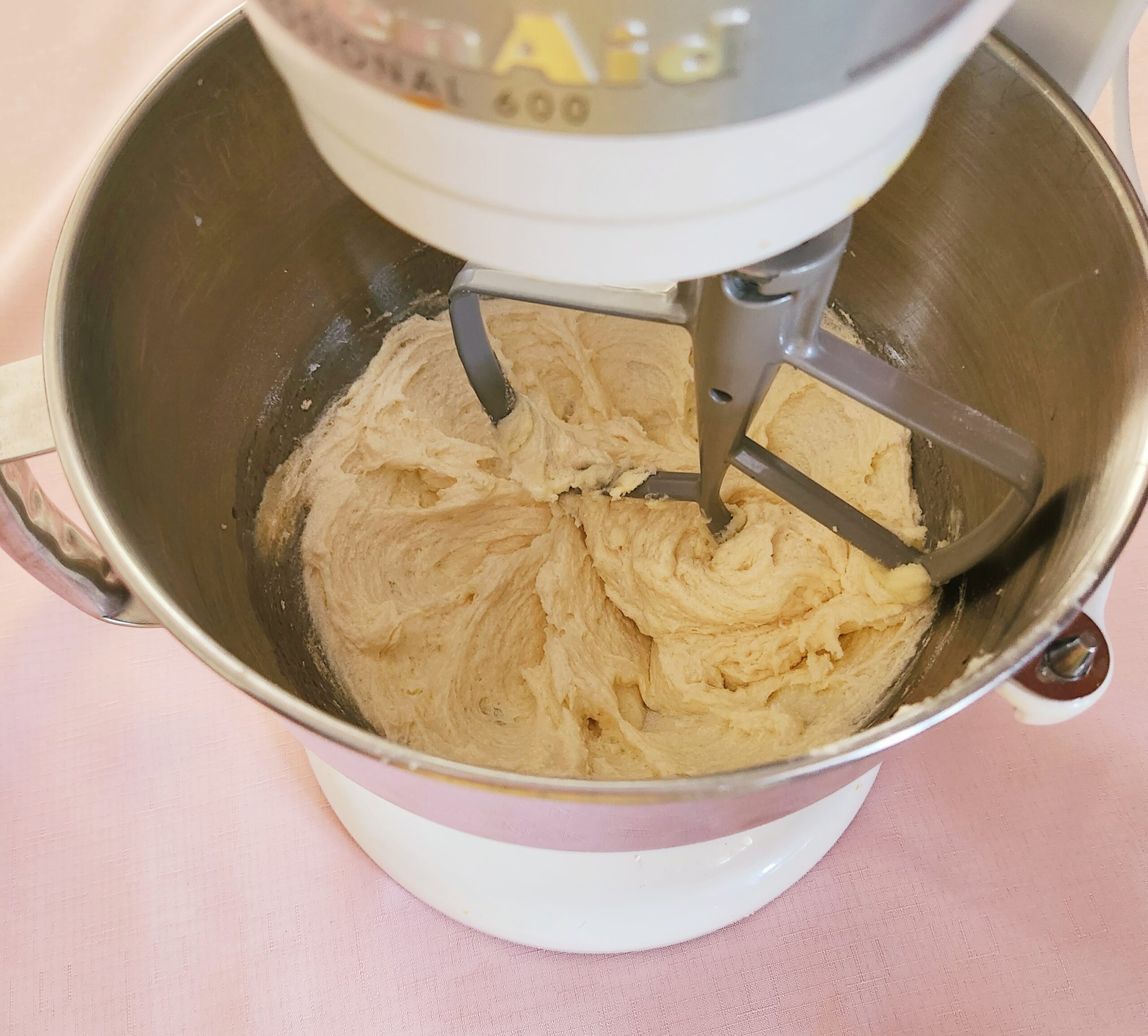
Onto the dry ingredient-milk alternations! It’s important to both start and end on the dry ingredients, for the batter to properly emulsify. Start with 1/3 of your flour mixture, stirring on the lowest setting until it’s almost fully incorporated, but a few streaks of flour remain, then pour in 1/2 of the milk. Scrape down the sides of the bowl.
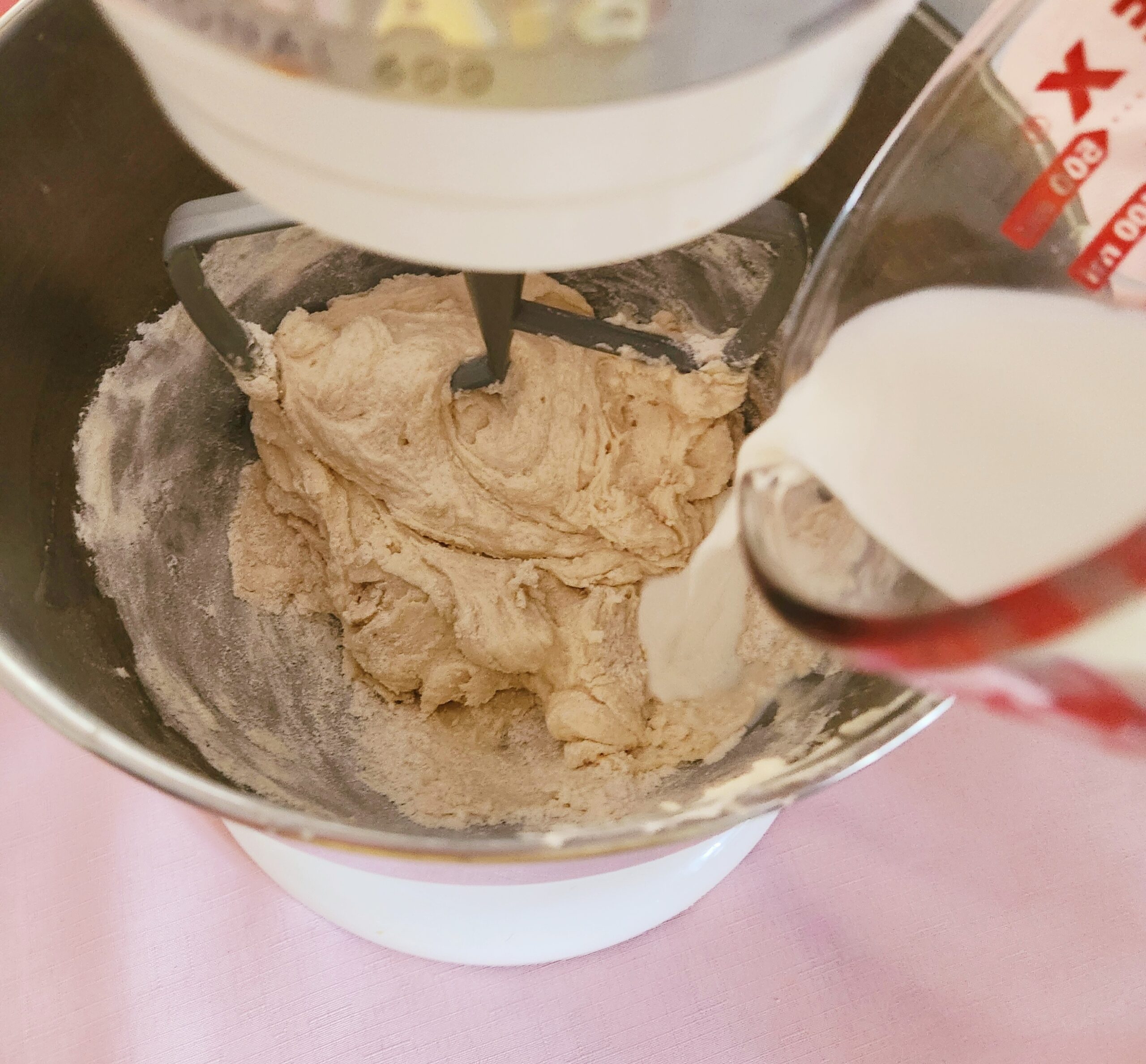
Beat on the lowest setting, until the batter is almost homogeneous, then add in another 1/3 of the flour mixture. Beat on the lowest setting until only a few streaks of flour remain, then pour in the last 1/2 of milk. Scrape down the sides of the bowl. Stir the batter on the lowest setting until it’s almost fully incorporated, then add in the last 1/3 of flour and beat it until it’s a beautifully homogeneous batter.
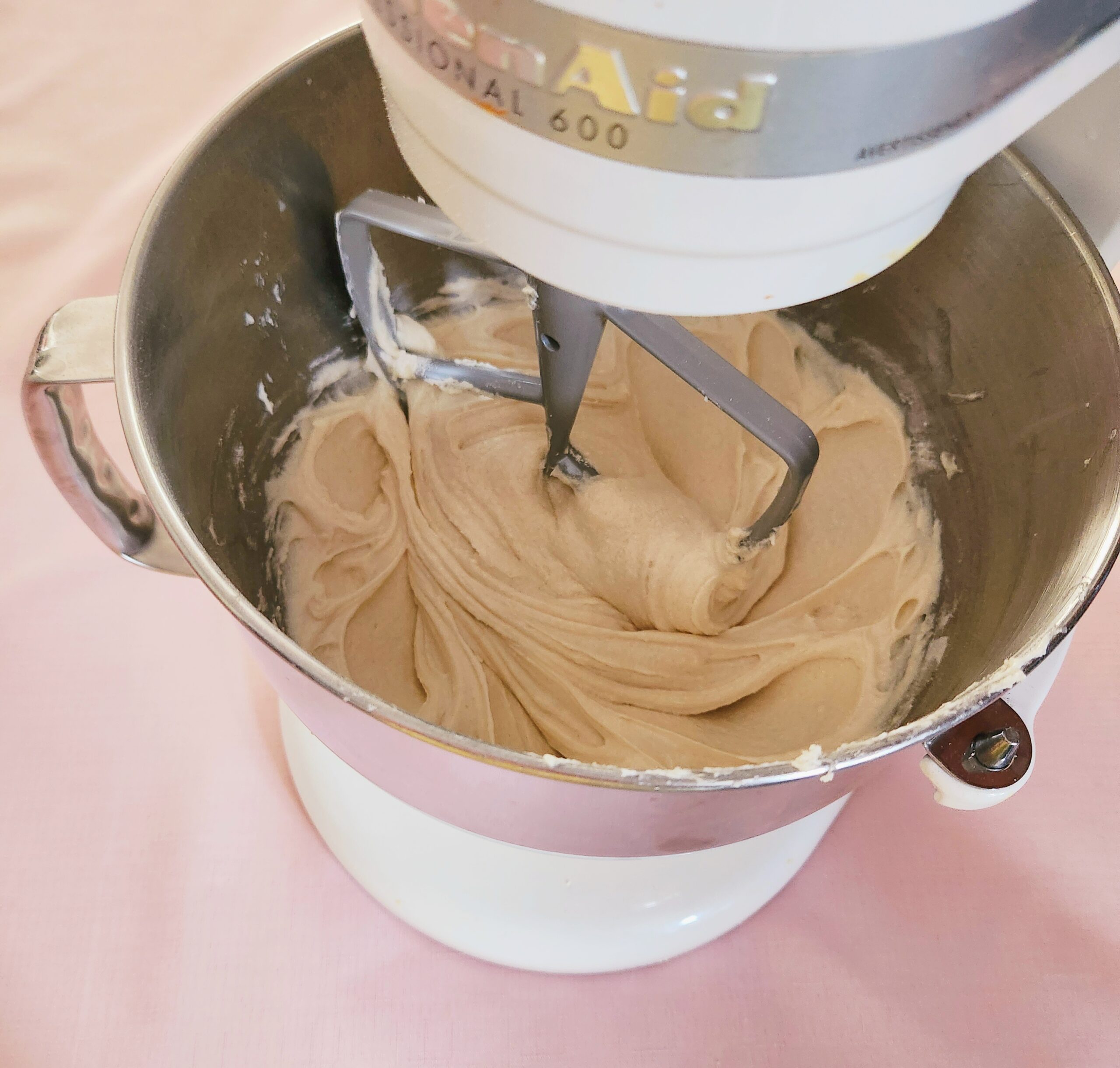
If you used cake flour as I advised, beat your batter on level 3 if you’re using a stand mixer, level 2 if you’re using a hand mixer, and with medium speed if you’re just using a whisk, for about a minute. Doing this will ensure properly developed gluten structure, so the cake wont collapse. Do not do this step if you’ve opted to use all purpose of pastry flour, the extra protein in the flour will make for a tougher cake if you do.
Pour the batter into your prepared 8×8 pan, scraping the batter off the sides of the bowl to get as much into the pan as you can.
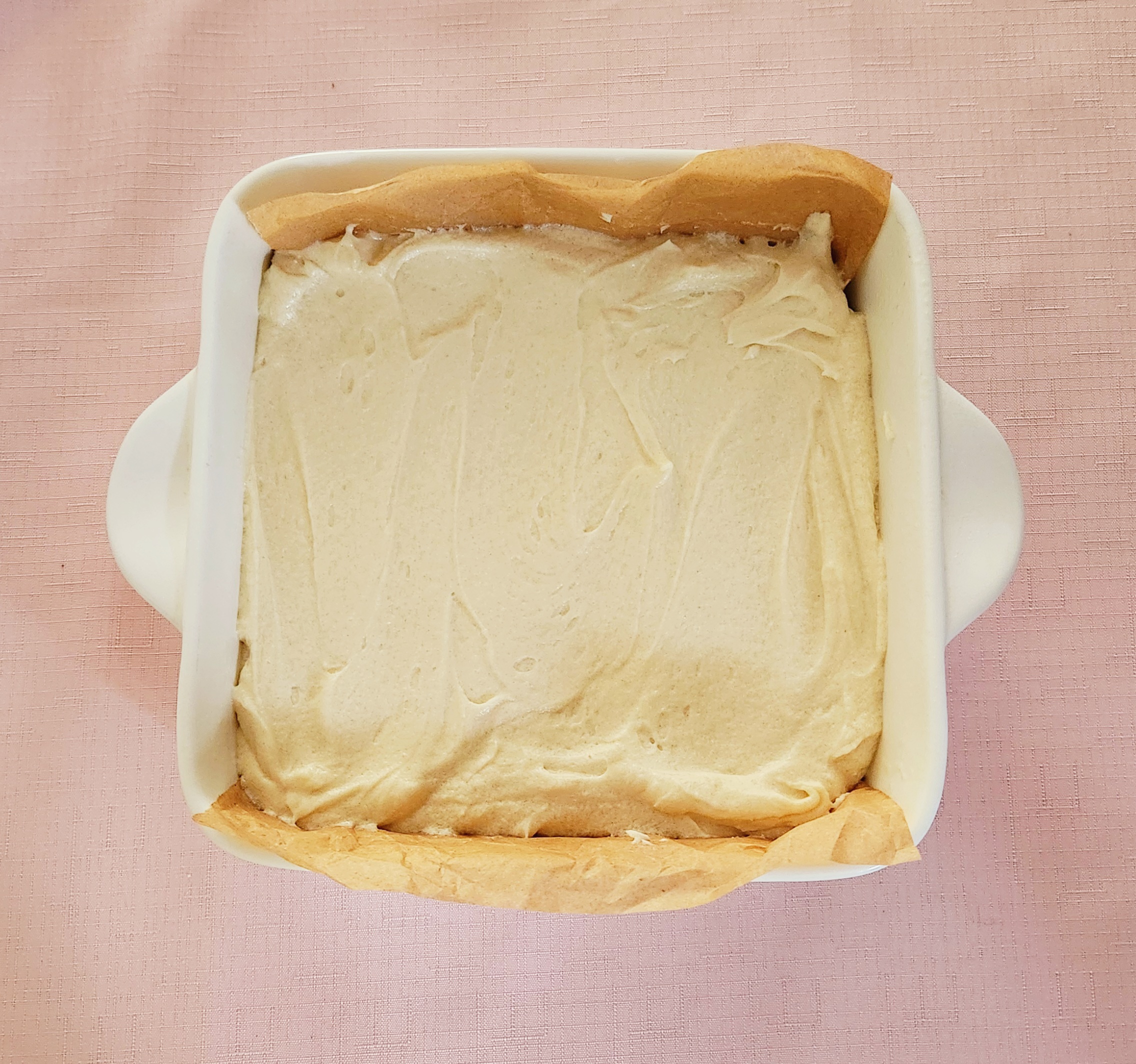
Bake it for 50 minutes or until a toothpick stabbed into the center of the cake comes out mostly clean, with just a few crumbs stuck to it. Make sure the cake is fully cooled before frosting it!
For the frosting, sift the powered sugar into the bowl of a stand mixer or a large mixing bowl if you’re using a hand mixer or a whisk, then add in the softened unsalted butter and cream them together. The color should go from a butter yellow color to white and fluffy. Scrape down the sides of the bowl with a silicone spatula to bring everything to the center of the bowl.
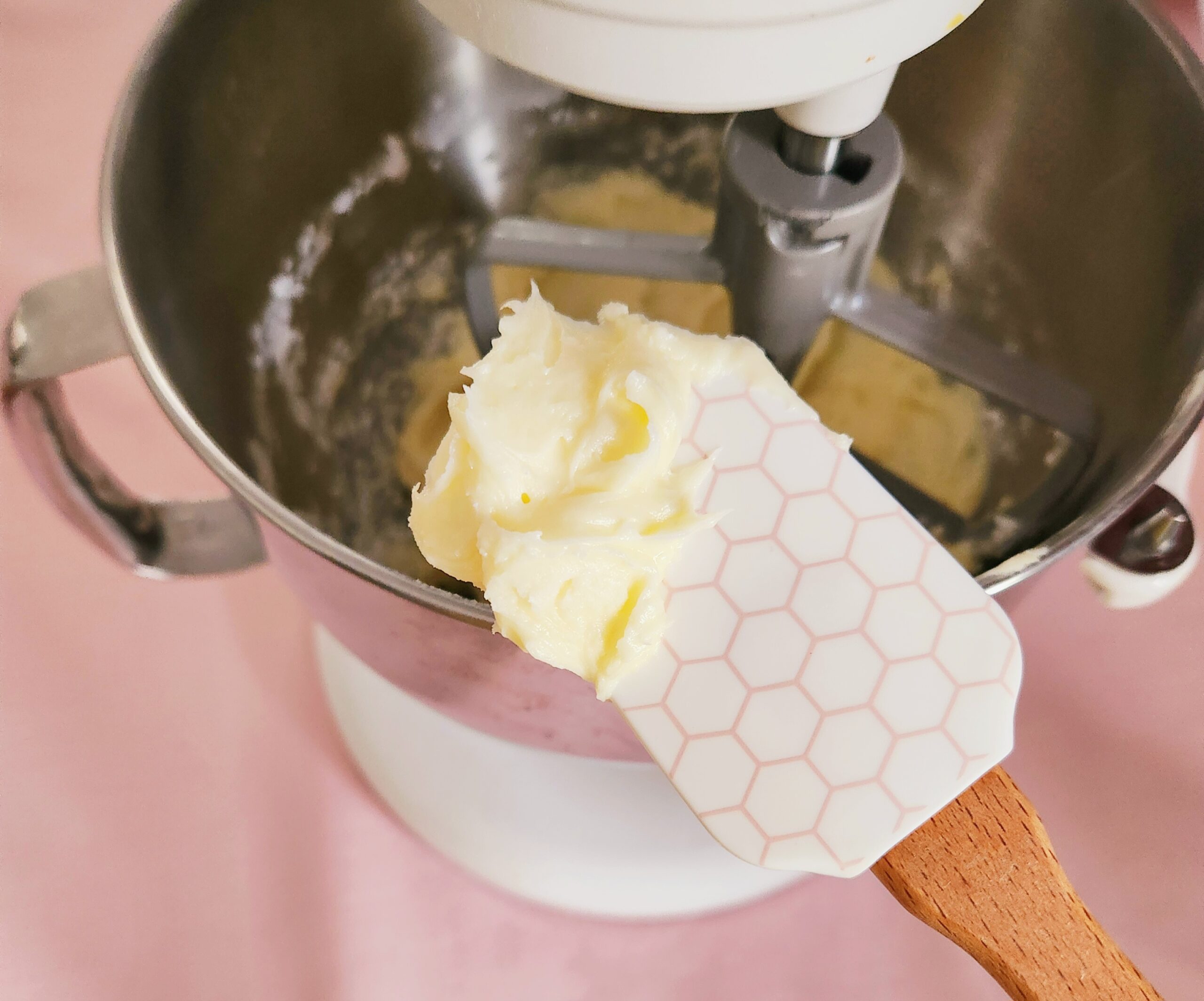
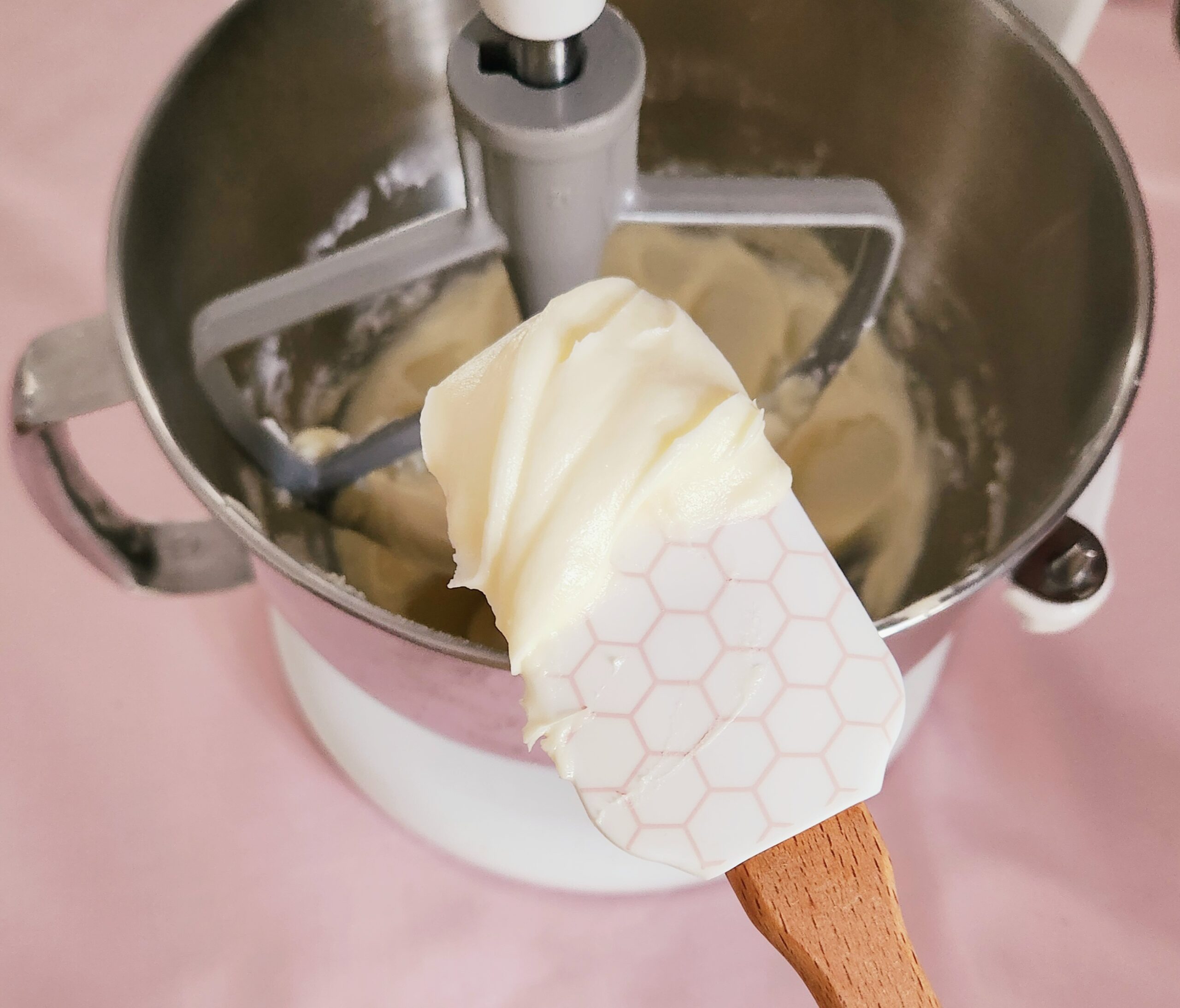
Add the corn syrup, salt, vanilla, and a few drops of food coloring if you’re using it. Beat your buttercream until everything has been fully incorporated and you have a homogenized frosting, scraping down the sides of the bowl as needed.
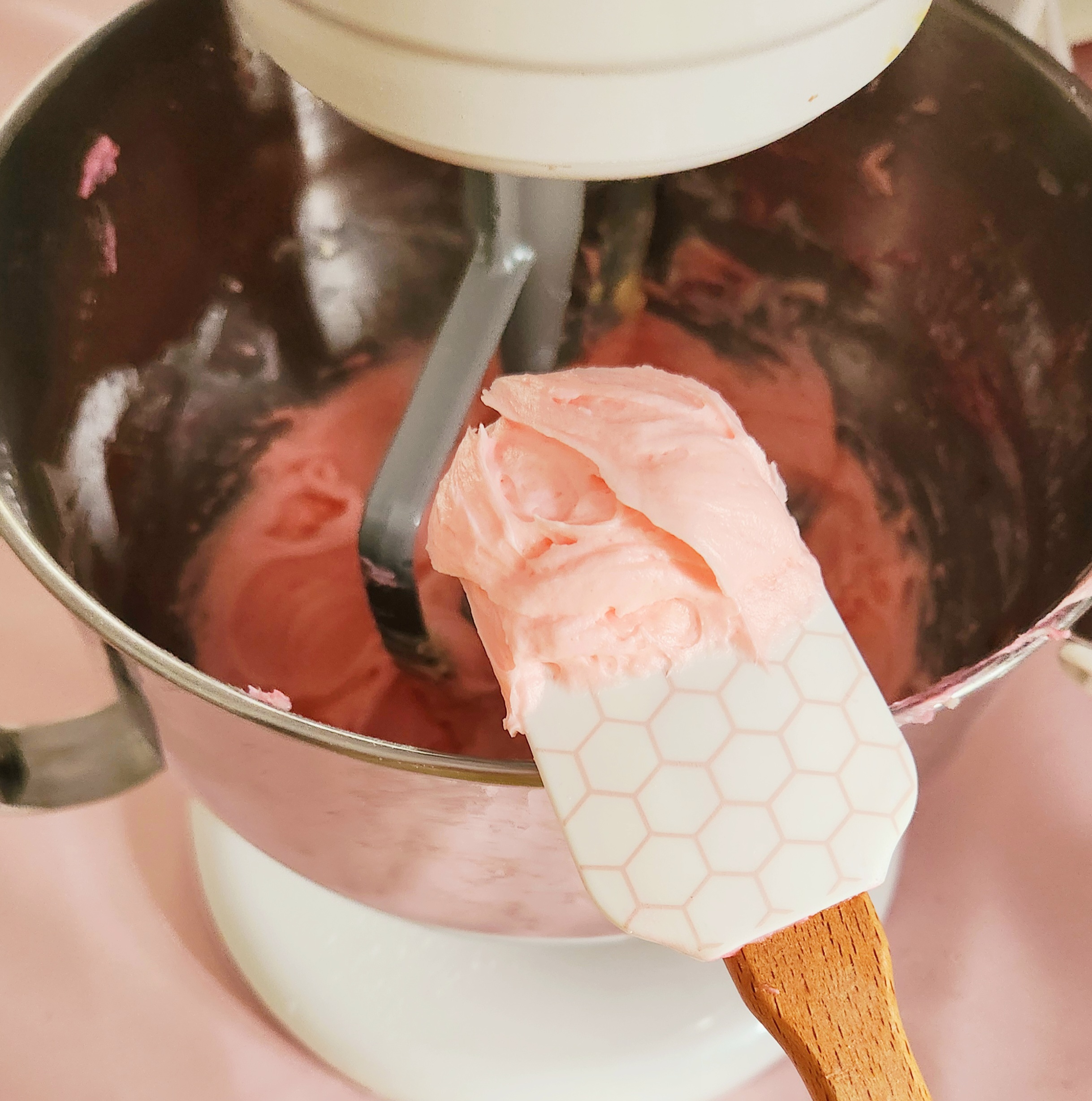
Heap all of your buttercream in the center of the cake, and using an offset spatula or a butter knife, spread it out into an even layer over the top of the cake.
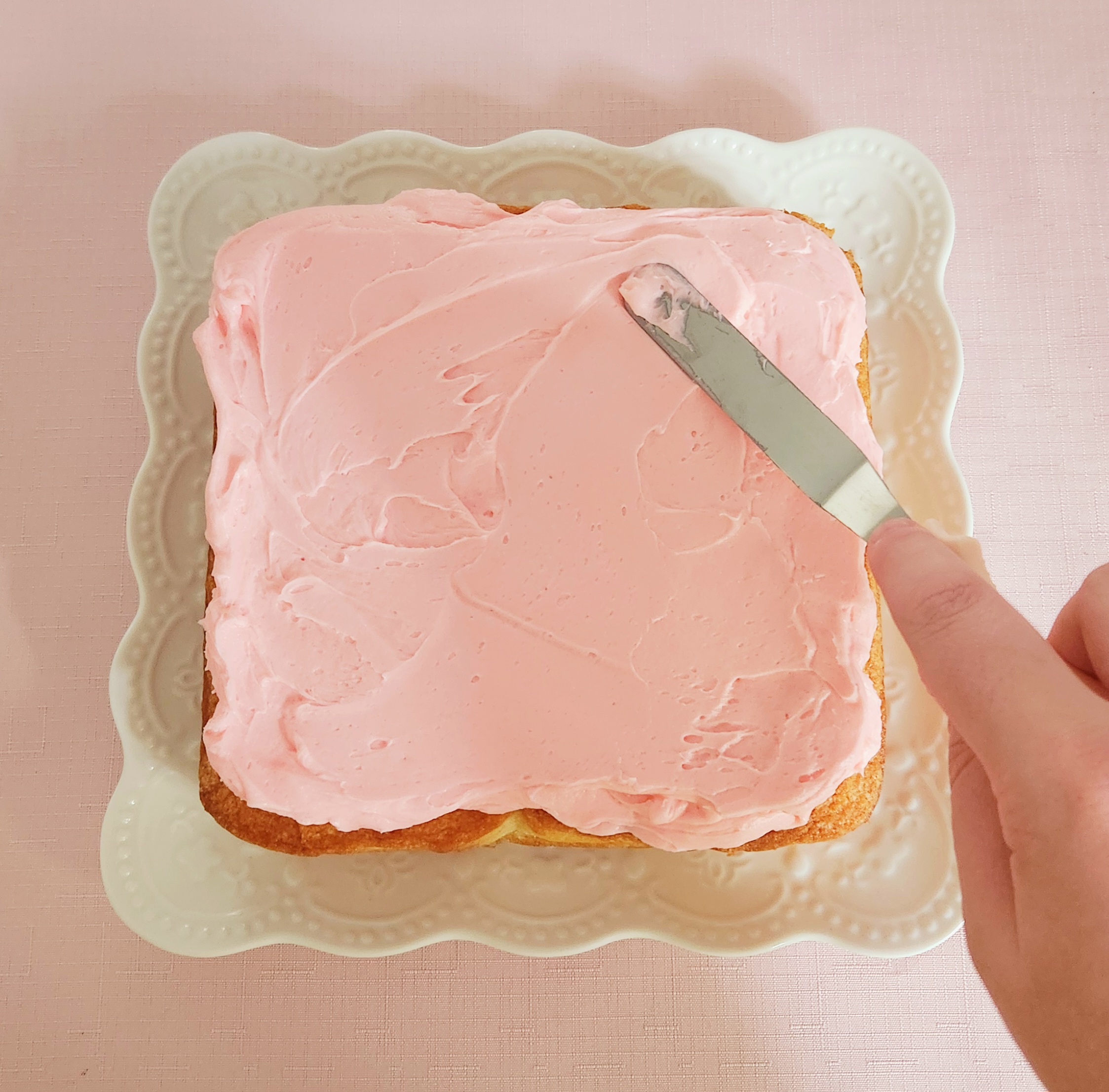
Decorate the now frosted cake with sprinkles, if you so choose. Just measure with your heart, you’ll know when you’ve added enough. Cut the cake into 9 servings by cutting an even 3×3 grid, grab a slice, and enjoy!
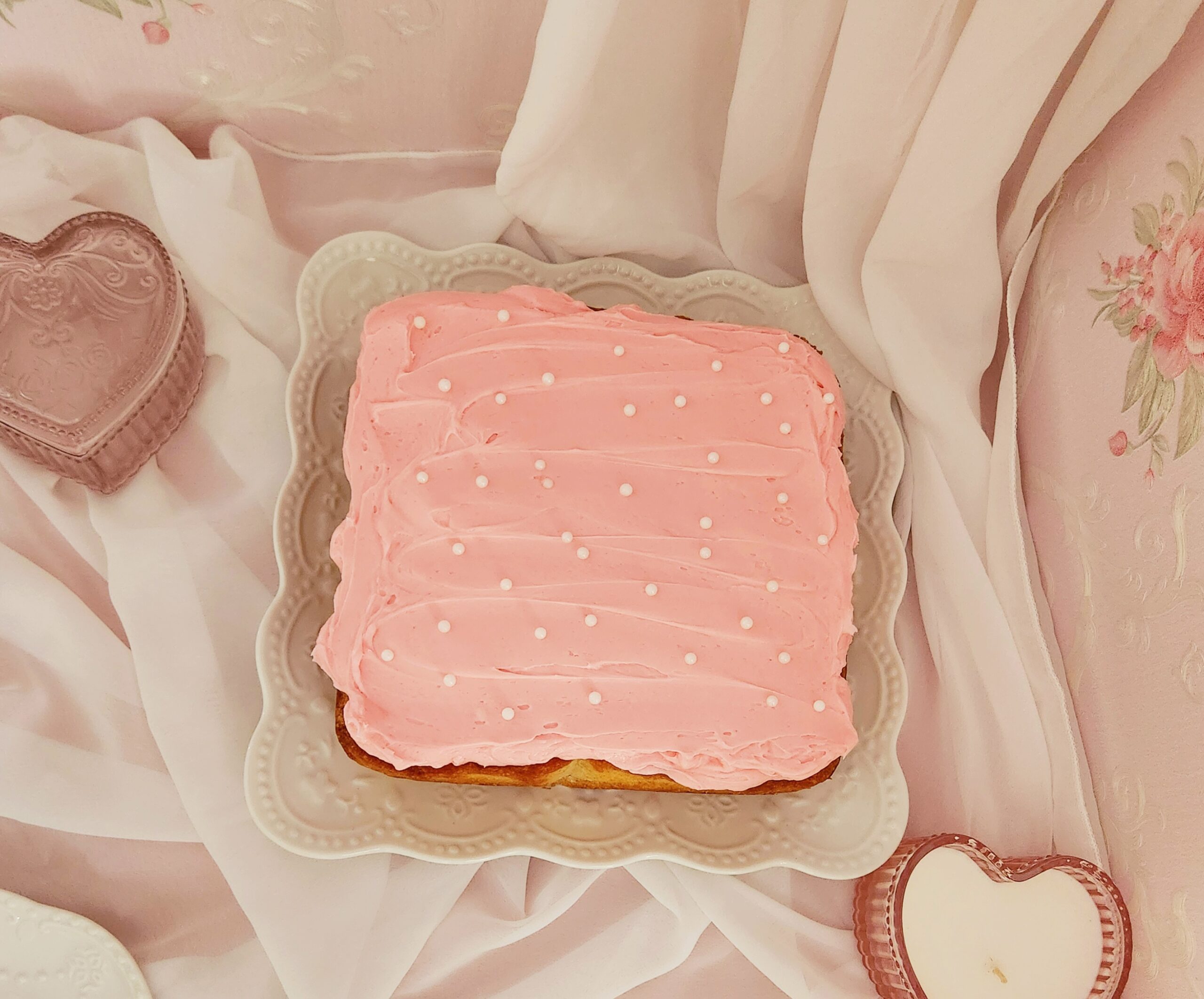
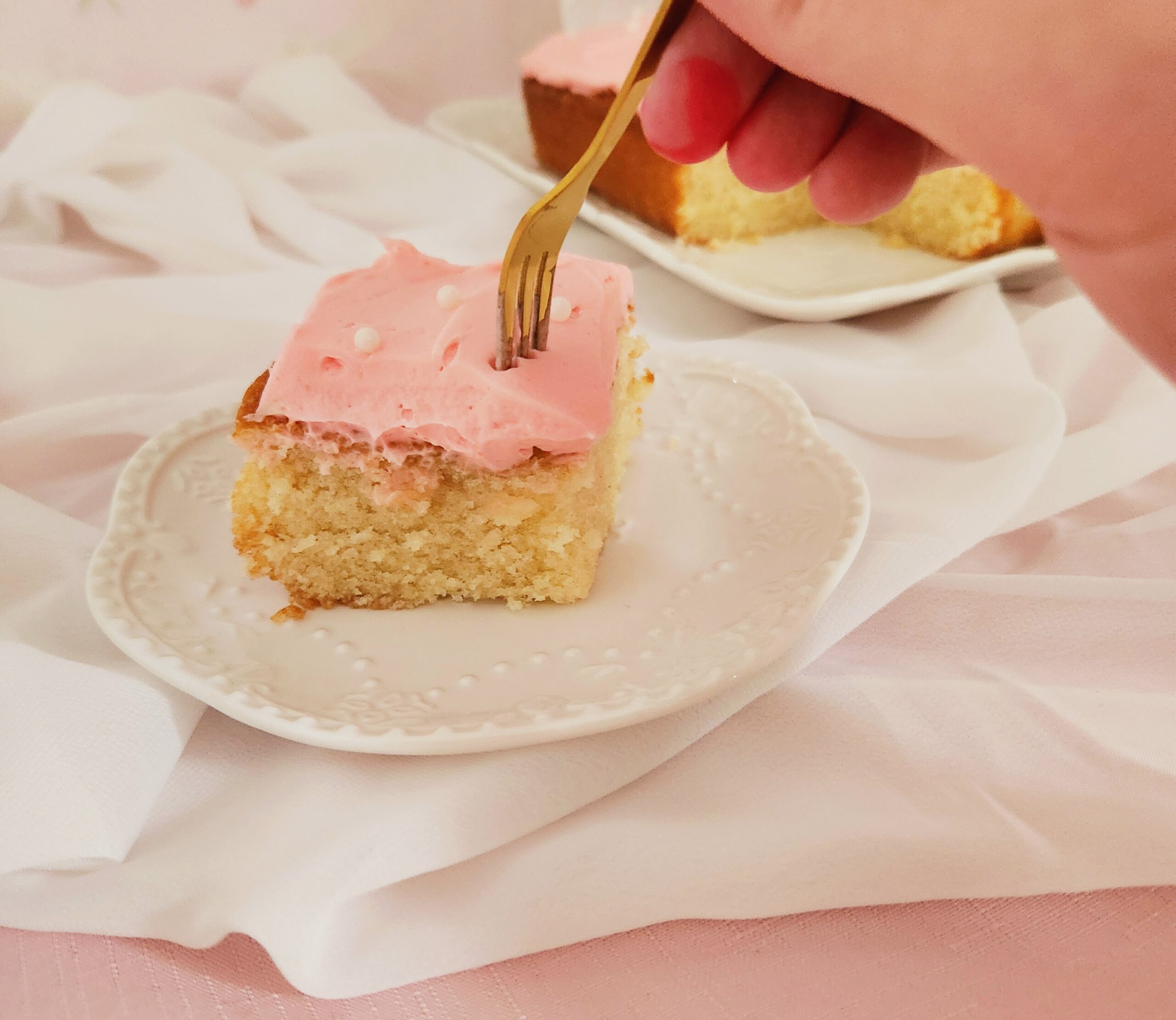
Simple White Cake
Bake Time: 325F for 50 minutes
Servings: 9 servings, 8×8 square pan
Total Time: 95 minutes
Prep Time: 45 Minutes
Ingredients
Cake Batter:
• 1 1/2 cups cake flour
• 1 teaspoon baking powder
• 1 teaspoon salt
• 12 Tablespoons unsalted butter, softened
• 1 1/4 cups granulated sugar
• 2 egg whites, room temperature
• 1 1/2 teaspoons vanilla extract
• 1/2 cup whole milk, room temperature
Frosting:
• 16 Tablespoons unsalted butter, softened
• 1 2/3 cups powdered sugar
• 3 Tablespoons light corn syrup
• 1/2 teaspoon salt
• 2 teaspoons vanilla extract
• Optional food coloring
Other
• Sprinkles
Instructions:
For the Cake Batter
1. Preheat the oven to 325F. Line the bottom of an 8×8 baking pan with parchment paper. Grease the sides of the pan with butter, or spray with a nonstick baking spray.
2. For the batter, sift together the cake flour, baking powder, and salt in a medium bowl, then set it aside for later on.
3. In the bowl of a stand mixer using the paddle attachment, or a large mixing bowl if you’re either using a hand mixer or just a whisk and your own two hands, cream together the softened butter and granulated sugar. It should go from a butter yellow color to almost white and very fluffy. This process should take around 2-3 minutes in the stand mixer or using the hand mixer, and around 5-6 minutes if you’re just using your mighty muscles. Scrape down the sides of the bowl with a rubber spatula.
4. Add in the two egg whites and vanilla extract, mixing until they’re fully incorporated and your mixture is homogeneous.
5. Time to alternatively add in the flour mixture and the milk. If you’re using a stand or hand mixer, keep it on level one. Start with the flour, add a third of the mixture to the butter mixture and combine until only a few streaks of flour remain, around 30 seconds or so. Scrape down the sides of the bowl, then add half of the milk, again mixing until it’s almost fully incorporated, around 30-45 seconds. Add another third of the flour mixture, beat for 30 seconds. Scrape down the sides of the bowl. Add the rest of the milk, and beat for 30-45 seconds.
6. Scrape down the sides of the bowl and throw in the rest of the flour. Once the batter is homogeneous, beat it for another minute to ensure structural integrity. If you’re using a stand or hand mixer, turn the dial to level 3 for this final mix.
7. Pour the batter into your prepared 8×8 pan, scraping the batter off the sides of the bowl to get as much into the pan as you can. Bake it for 50 minutes or until a toothpick stabbed into the center of the cake comes out mostly clean, with just a few crumbs stuck to it.
8. Allow the fully baked cake to rest in the pan for 10 minutes, then remove it from the pan and allow it to fully cool on a baking rack before frosting it.
For the Frosting
1. Sift the powered sugar into the bowl of a stand mixer or a large mixing bowl if you’re using a hand mixer or a whisk, then add in the softened unsalted butter and cream them together. The color should go from a butter yellow color to white and fluffy. Scrape down the sides of the bowl with a rubber spatula to bring everything to the center of the bowl.
2. Add the corn syrup, salt, vanilla, and a few drops of food coloring if you’re using it. Beat your buttercream until everything has been fully incorporated and you have a homogenized frosting, scraping down the sides of the bowl as needed.
Assembly
1. Once your cake is fully cooled off, it’s time to frost! Heap all of your buttercream in the center of the cake, and using an offset spatula or a butter knife, spread it out into an even layer over the top of the cake.
2. Decorate the now frosted cake with sprinkles, if you so choose. Just measure with your heart, you’ll know when you’ve added enough. Cut the cake into 9 servings by cutting an even 3×3 grid, grab a slice, and enjoy!
Tips
• The sponge (baked part) should be fully cooled off before you frost it. If you’re impatient, the frosting is going to melt and run off the cake, and will lose that silky texture!

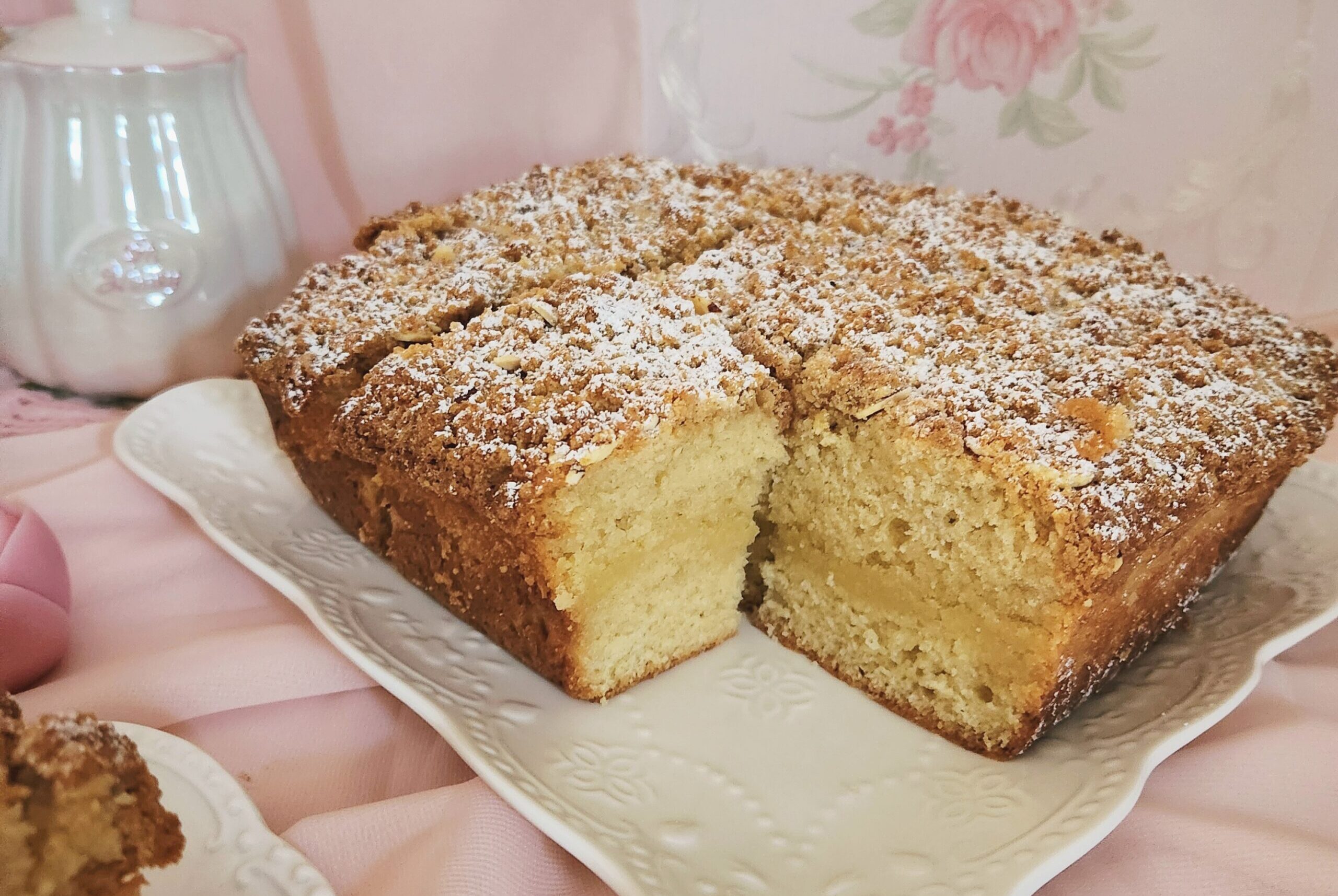
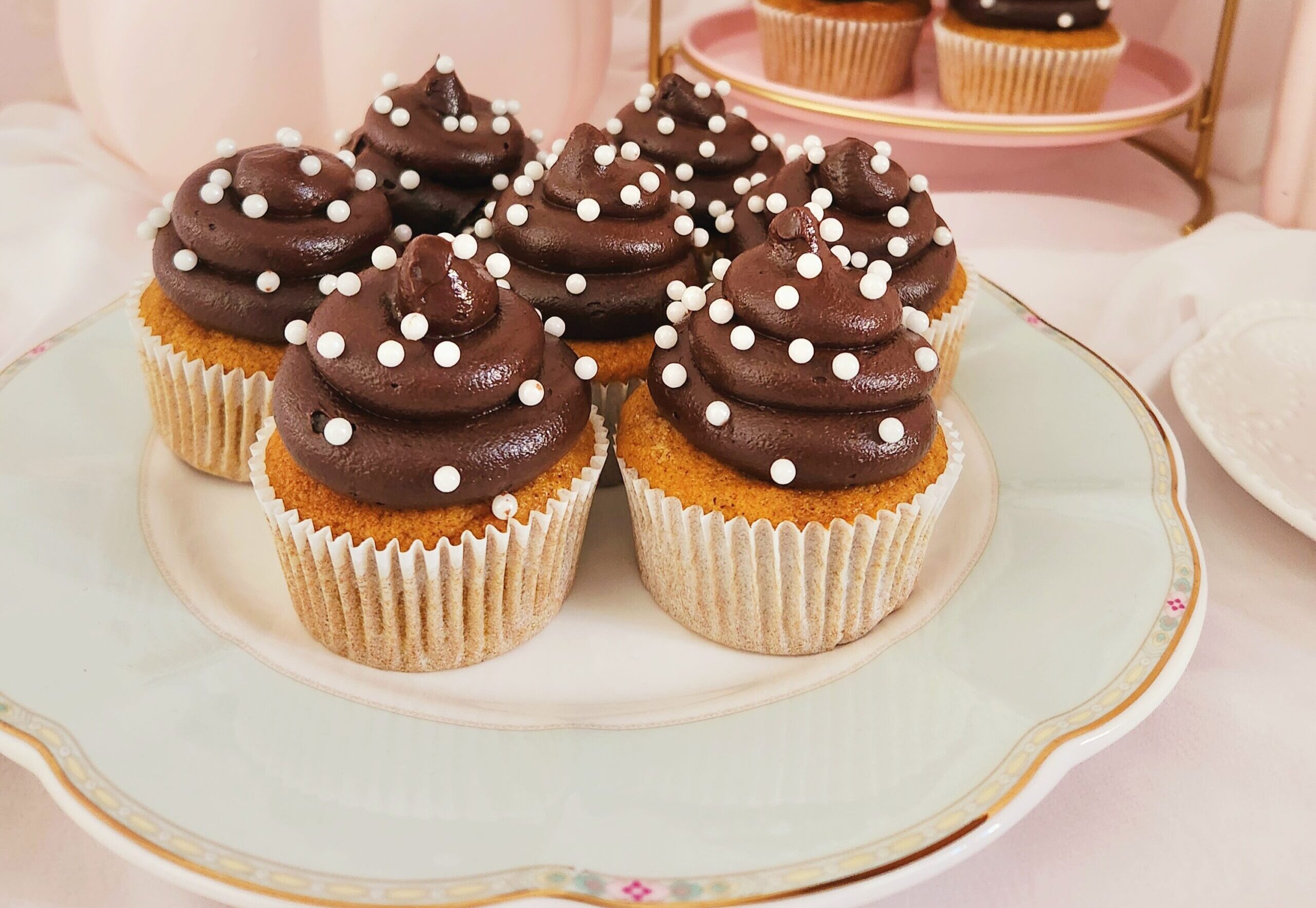
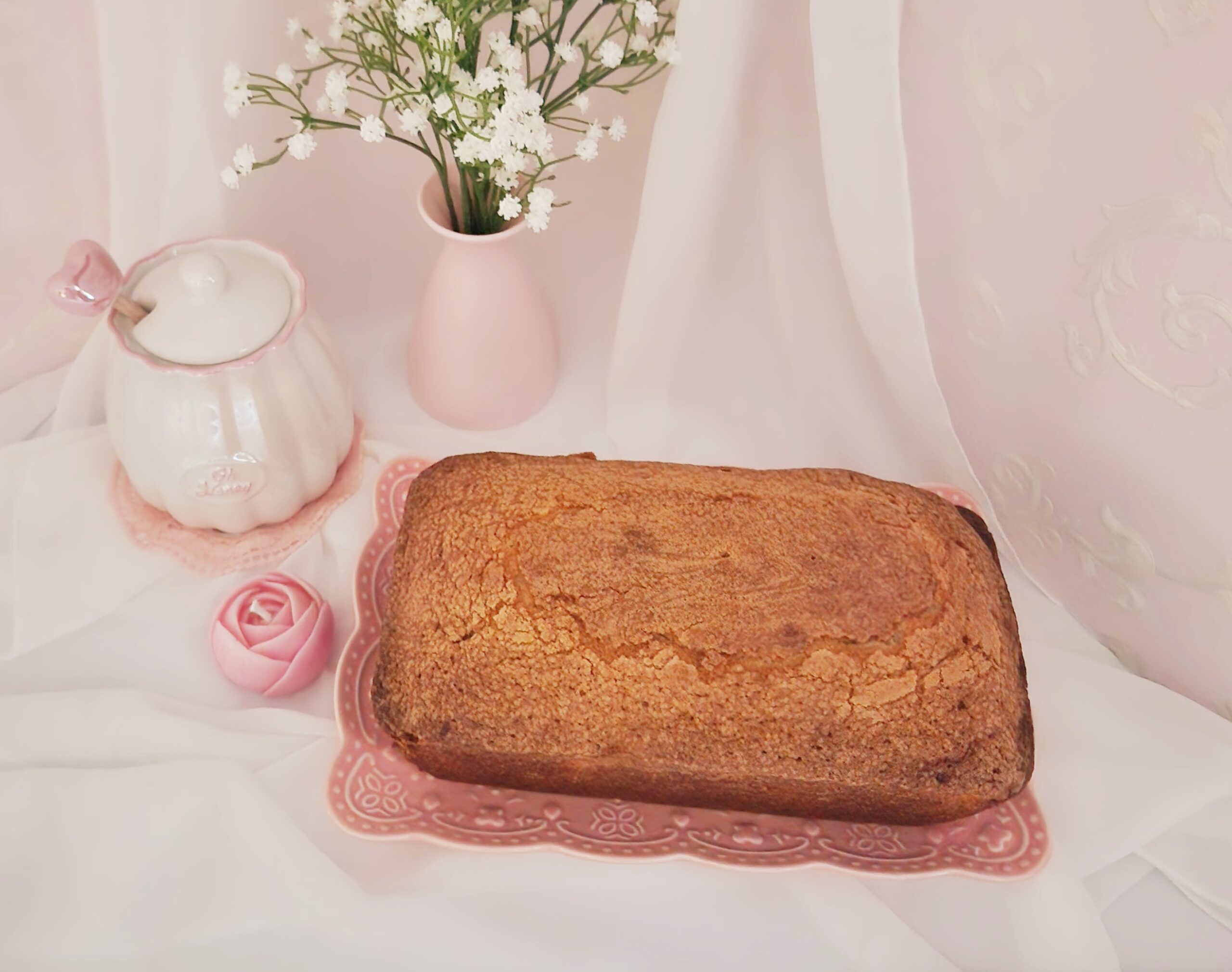
0 Comments